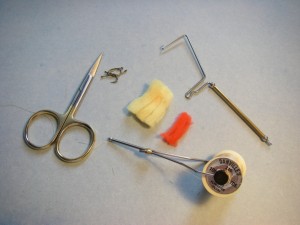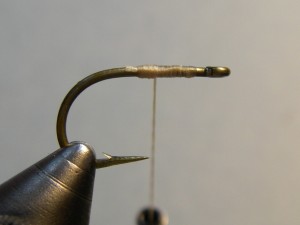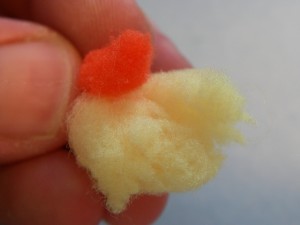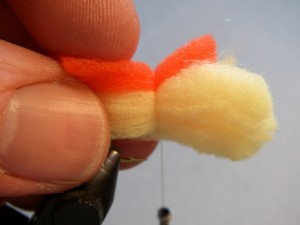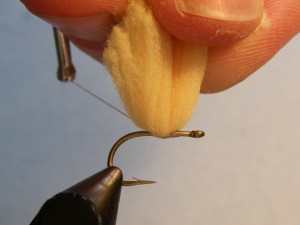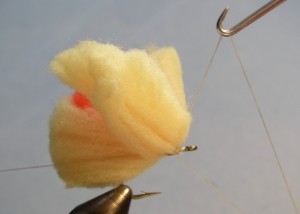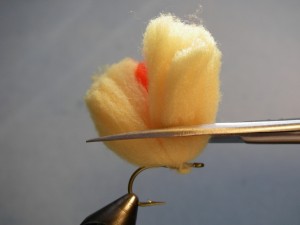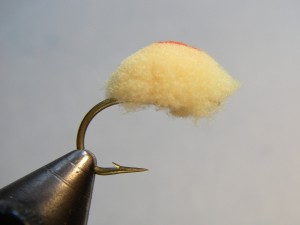Matching the Hatch is often associated with trout fishing, but not necessarily with Steelhead fishing. Imitating the specific natural insects fish key in on is important to the success of the trout angler however this same approach should be used by steelhead anglers looking to imitate their prey’s primary food source – eggs.
Egg flies have been used for decades not only because they are easy to tie or inexpensive to buy, but more importantly because they are effective. With increased angling pressure, water conditions, as well as factors only known by the steelhead themselves, they often become selective on size and color. This article’s goal is to provide you with a better understanding of what egg to use and when. Of course it’s not guaranteed, but put others’ experience in your corner to optimize your steelhead fishing and hopefully a well-earned steelhead into your net.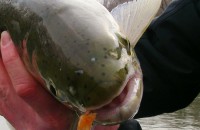
Matching the Hatch
Regardless of when you fish steelhead and what egg you are trying to imitate, know that the eggs themselves change. After being in the water – free drifting or trapped in a selected gravel bed – eggs become less colorful, a bit translucent and eventually opaque. Depending on the timing of your fishing trip in relation to the “egg drop”, color plays a large factor and there are two ways to determine what is ideal:
1. Experience. Fishing and having certain successes or failures can help you 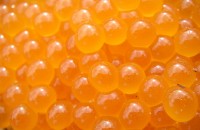 define color combos for particular times. Keeping notes in a journal can help keep track of what can easily be forgotten between seasons and a few beers.
define color combos for particular times. Keeping notes in a journal can help keep track of what can easily be forgotten between seasons and a few beers.
2. When fishing rivers that have a respectable trout population, use their selectiveness as an indication of the right color and size. Catching trout? Proceed. Not catching tout? Change your egg pattern.
When fishing for steelhead in the fall directly behind spawning salmon – color and size becomes more important and is where “matching the hatch” is key. In 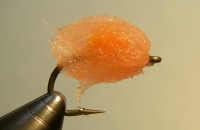 this case, the eggs are often fresh, having a more realistic color to them.
this case, the eggs are often fresh, having a more realistic color to them.
Want to know what a real salmon egg looks like? Look on the ground at access sites or near fish cleaning stations to match your egg patterns – its not that much different than catching a mayfly out of the air and matching it to a fly in your box when trout fishing. The same holds true in the spring when imitating natural steelhead eggs.
Fall Steelhead
With this in mind, I like fishing for fall steelhead, the majority of the time with two egg flies; one larger, brighter pattern as an attractor and a second, smaller, more realistic pattern imitating what is coming down the river. Often the top positioned fly is a multicolored pattern like a Clown or two-colored Rag Egg if not a Nuke Egg. I saw my first clown egg while fishing steelhead in Alaska in the mid-1990s and thought it was a joke – it was about the size of a quarter and included more colors than a small package of Crayola crayons. But with time, understanding, and some luck, I have learned that this multi-color configuration and approach can be significant to my success fishing for steelhead right here in Michigan. It’s a good idea to run this egg pattern in a large size when the water is full of leaves
when a smaller pattern could easily be lost in all of the
drifting debris.
Most anyone fishing steelhead in Michigan recognizes the Nuke Egg as an effective pattern that is an improvement over the original GloBug. The Nuke can be tied as an attractor or natural imitator depending on size and color. One of its key attributes is the veil or shroud of yarn that covers the nucleus of the pattern giving it a natural, transparent look when wet. The advantage of the Nuke Egg is its exacting nature to imitate the natural eggs drifting down the river. Some of these color combinations include: Egg over Sockeye, Pink Lady over Shrimp Pink, Apricot Supreme over Steelhead Orange, Salmon Egg over Chartreuse or Nuke Egg everyone’s favorite – spring or fall: Oregon Cheese over Steelhead Orange. Worthy attractor colors are Chartreuse over Flame, or Flame over Cerise.
Steelhead in the Great Lakes perform their annual spawning each year during the spring. The largest numbers of fish are in the river sometime in March and April depending on water levels and temperatures. During this time period, the river is also used by walleyes, resident rainbow trout, suckers and carp (typically in that order with steelhead spawning the same time as rainbow trout) as their spawning area. As a result, millions of eggs drift down the river becoming a significant food source for all fish in the river, notably steelhead. The successful angler is often fishing with an egg pattern best imitating the natural egg – its color and shape in addition to how it relates to water conditions.
Spring Steelhead
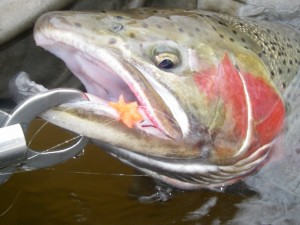 Spring water conditions are often found to have a stain or be quite high and dirty. When this is the case, I have found patterns larger than naturals to be the most effective. Egg patterns like Rags, Nukes and Glo Bugs tied in various colors and almost as big as a dime, I think, do a better job of grabbing a fish’s attention rather than imitate the food source. But those times of the spring when the absence of rains and thaws leave the water with good clarity, size and color becomes significant. Patterns like sucker spawn in pale yellow imitate that of both suckers and walleye, where the natural characteristics of Nuke Eggs and Glo Bugs in various colors and hues can be identical to those of natural steelhead eggs drifting down the river.
Spring water conditions are often found to have a stain or be quite high and dirty. When this is the case, I have found patterns larger than naturals to be the most effective. Egg patterns like Rags, Nukes and Glo Bugs tied in various colors and almost as big as a dime, I think, do a better job of grabbing a fish’s attention rather than imitate the food source. But those times of the spring when the absence of rains and thaws leave the water with good clarity, size and color becomes significant. Patterns like sucker spawn in pale yellow imitate that of both suckers and walleye, where the natural characteristics of Nuke Eggs and Glo Bugs in various colors and hues can be identical to those of natural steelhead eggs drifting down the river.
A well stocked fly box for trout fishing is important to success and it’s no different for steelhead. Learn your favorite river, the spawning times of the various species, and what works in particular conditions and key in on what steelhead are eating. Having egg patterns in various sizes, colors and shapes and learning when to use them and why can be the difference between catching steelhead on a consistent basis and catching a steelhead.
Learn how to tie 4 different egg patterns – go to the Fly Tying page and select the pattern you want to tie.

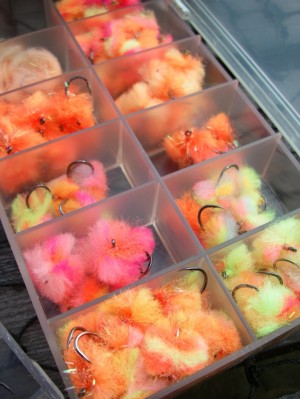
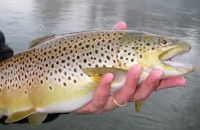
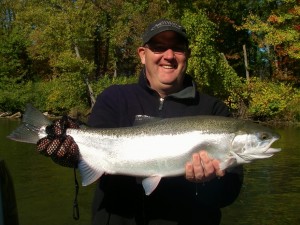
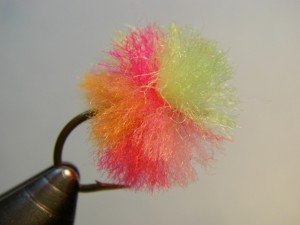
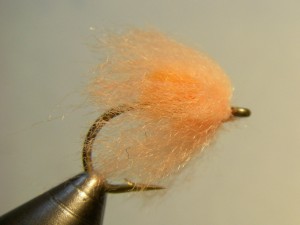
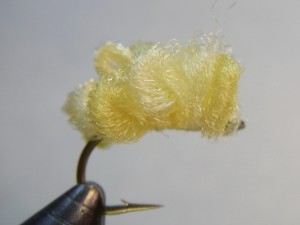
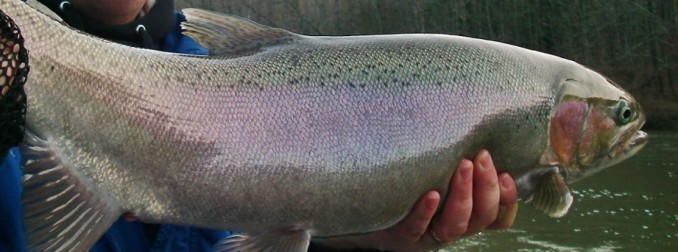
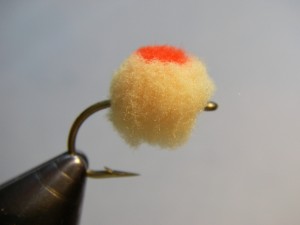 The typical material for tying Glo Bugs is Glo Bug Yarn or Egg Yarn and many, including myself have found tying nice, round looking egg flies is difficult when using this material. In the mid-1990’s a new material, McFly Foam yarn, hit the market and tying nice, round eggs has been easier ever since. It’s available in huge array of colors and anglers can mix them up or incorporate dots very easily for a custom combination.
The typical material for tying Glo Bugs is Glo Bug Yarn or Egg Yarn and many, including myself have found tying nice, round looking egg flies is difficult when using this material. In the mid-1990’s a new material, McFly Foam yarn, hit the market and tying nice, round eggs has been easier ever since. It’s available in huge array of colors and anglers can mix them up or incorporate dots very easily for a custom combination.